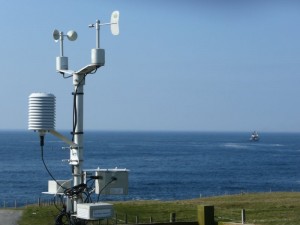Blog: Sir David Mackay’s important legacy
Neil Kermode reflects on the untimely death of Sir David Mackay, the physicist and government scientific adviser who visited EMEC in 2010 and has left an important legacy in understanding climate change and renewable energy.
It was a great shock to hear that Sir David MacKay, author of Sustainable Energy Without The Hot Air died last week at the age of 48 from stomach cancer.
Sir David visited EMEC when he came to Orkney a few years ago. People were struck by the rationality of his approach in seeking to measure and compare the important issues that are leading to climate change, and not just the populist ones. He used the simple method of resolving everything to kWh to allow rational comparison.
This lets us focus policy interventions across the normal boundaries of heat vs transport vs electricity vs whatever, rather than seeing them in silos. So driving an average car 50km consumes about the same energy as an old style 40W light bulb left on all day. Unplugging a phone charger saves about the same as that car consumed in about 1 second. This approach also allows you to model the costs of intervention: would we get more bang for our kWh making our cars more efficient, or putting in video conferencing to avoid having to use cars in the first place.
Understanding our own individual energy impacts is critical to mobilising our desire for change. Sir David engagingly provided us with a really good tool to do that.
He also reminded me how a scientific approach is often ignored and rational debate is de-railed. I believe his best example was when comparing cats and wind turbines. On this occasion it was not their energy generating capacity, but that of their ability to kill birds. Based on research in Denmark, the study showed the number of bird deaths attributed to wind, which at that time was approximately 30,000 birds killed in a year. This IS a pity, but he then went on to show that cars in the UK kill around 1,000,000 birds per year and cats around 55,000,000, and the same number are killed by windows as cats. However it will be a brave journalist who tackles our cat lovers or architecture… it is much easier to tilt at windmills.
I can’t say we agreed on everything as the book is somewhat dismissive of marine energy. But the book does give us a benchmark of both technical comparison and a good starting point. It is now out of date due to the progress made in reducing the inputs (and therefore the costs) of renewables and the efficiencies of many items has also increased. At EMEC we have seen improvements in both the energy capture of devices over time and also the reduction in energy inputs. Therefore the ground has shifted since publication, but the principle remains useful.
Sir David’s lasting contribution to this field will be the clever and helpful basis of comparison of different energy sources. It is a sound method to help us focus the efforts of humankind on the things that matter, rather than thinking that unplugging a phone charger is going to save the planet… It is going to be much, much harder than that!






